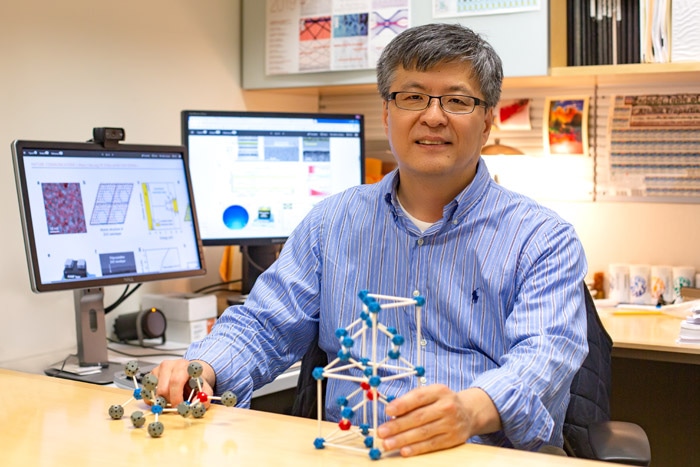May 30 2019
Over the years, many electronic devices, including computers, have become smaller and faster as computer-chip manufacturers have learned a way to reduce the size of individual transistors, which are small electrical switches transferring digital information.
 Dr Kyeongjae Cho, professor of materials science and engineering, and his UT Dallas collaborators developed the fundamental physics of a multi-value logic transistor based on zinc oxide. (Image credit: University of Texas at Dallas)
Dr Kyeongjae Cho, professor of materials science and engineering, and his UT Dallas collaborators developed the fundamental physics of a multi-value logic transistor based on zinc oxide. (Image credit: University of Texas at Dallas)
Researchers’ quest for the tiniest possible transistor has made it possible to pack more of these switches into a single chip. However, that race to the bottom is nearly over—scientists are quickly approaching the physical minimum with regards to the size of transistors, with the latest models measuring just 30 atoms—or down to roughly 10 nm—wide.
The processing power of electronic devices comes from the hundreds of millions, or billions, of transistors that are interconnected on a single computer chip. But we are rapidly approaching the lower limits of scale.
Dr Kyeongjae Cho, Professor, Materials Science and Engineering, The University of Texas at Dallas
The microelectronics sector is seeking alternative technologies in order to extend the quest for faster processing speed. Cho’s research may provide a solution by expanding the transistor’s vocabulary. The study has been published online in the journal Nature Communications on April 30th, 2019.
Only two values of information are conveyed by traditional transistor: A transistor, as a switch, is either on or off and this translates into the 0s and 1s of binary language.
Increasing the amount of information that can be conveyed by an individual transistor by introducing intermediate states between the off and on states of binary devices is one way to boost the processing capacity without adding extra transistors. Based on this principle, a so-called multi-value logic transistor would enable a more number of operations and make it possible to process a larger amount of data in one device.
“The concept of multi-value logic transistors is not new, and there have been many attempts to make such devices,” stated Cho. “We have done it.”
With the help of theory, simulations, and design, Cho’s team at UT Dallas created the fundamental physics of a multi-value logic transistor on the basis of zinc oxide. The performance of a prototype device was successfully developed and assessed by the team’s collaborators in South Korea.
The novel device developed by Cho is capable of two electronically reliable and stable intermediate states between 1 and 0, increasing the number of logic values for each transistor from two to three, or even four.
According to Cho, the latest study is important because the technology is not only compatible with current configurations of computer chips, but it could also close the gap between present generation of computers as well as quantum computers, the next promising breakthrough in computing power.
Generally, a traditional computer makes calculations by using the accurate values of 0s and 1s, but in a quantum computer, the fundamental logic units are more fluid with values that can occur as a combination of 0s and 1s simultaneously or anywhere in between. Even though large-scale quantum computers are yet to be realized on a commercial level, it has been theorized that these devices have the potential to store more amounts of information and solve specific issues in a much faster when compared to existing computers.
A device incorporating multi-level logic would be faster than a conventional computer because it would operate with more than just binary logic units. With quantum units, you have continuous values. The transistor is a very mature technology, and quantum computers are nowhere close to being commercialized. There is a huge gap. So how do we move from one to the other? We need some kind of evolutionary pathway, a bridging technology between binary and infinite degrees of freedom. Our work is still based on existing device technology, so it is not as revolutionary as quantum computing, but it is evolving toward that direction.
Dr Kyeongjae Cho, Professor, Materials Science and Engineering, The University of Texas at Dallas
The novel technology developed by Cho and his team utilizes a new configuration of two forms of zinc oxide integrated to create a composite nanolayer, which is subsequently incorporated with layers of other types of materials in a superlattice.
The scientists found that they can possibly realize the physics required for multi-value logic by integrating crystals of zinc oxide, known as quantum dots, into amorphous zinc oxide. As a matter of fact, the atoms containing an amorphous solid are not as strictly ordered as they are in crystalline solids.
By engineering this material, we found that we could create a new electronic structure that enabled this multi-level logic behavior. Zinc oxide is a well-known material that tends to form both crystalline solids and amorphous solids, so it was an obvious choice to start with, but it may not be the best material. Our next step will look at how universal this behavior is among other materials as we try to optimize the technology. Moving forward, I also want to see how we might interface this technology with a quantum device.
Dr Kyeongjae Cho, Professor, Materials Science and Engineering, The University of Texas at Dallas
Cho has applied for a patent.
Dr Jeongwoon Hwang, a former postdoctoral researcher in Cho’s laboratory and presently at Chonnam National University in South Korea, and Dr Jiyoung Kim, professor of materials science and engineering at UT Dallas, are co-authors of the article published in Nature Communications, along with scientists at South Korean universities: Yonsei University, Gwangju Institute of Science and Technology, Hanyang University, Ulsan National Institute of Science and Technology, and Kookmin University.
The National Research Foundation of Korea supported the study.